Hydrogenetic and Diagenetic Controls on the Specific Surface Area of Polymetallic Nodules in Deep Ocean Basins
Abstract
:1. Introduction
2. Samples and Methods
2.1. Samples
2.2. Methods
3. Results
3.1. Nodule Transition Metals and REEs
3.2. Mineralogical Composition of Nodules
3.3. Nodule-Specific Surface Areas
4. Discussion
4.1. Genesis Discrimination
4.2. Correlation Analysis among Transition Metals, Mineralogy, and SSA
5. Summary
Author Contributions
Funding
Data Availability Statement
Acknowledgments
Conflicts of Interest
References
- Chester, R.; Jikells, T. Marine Geochemistry, 3rd ed.; Wiley-Blackwell: Chichester, UK, 2012; pp. 334–344. [Google Scholar]
- Kuhn, T.; Wegorzewski, A.; Rühlemann, C.; Vink, A. Composition, formation, and occurrence of polymetallic nodules. In Deep-Sea Mining; Chapter 2; Sharma, R., Ed.; Springer: Cham, Switzerland, 2017; pp. 23–63. [Google Scholar]
- Hein, J.R.; Koschinsky, A.; Kuhn, T. Deep-ocean polymetallic nodules as a resource for critical materials. Nat. Rev. Earth Environ. 2020, 1, 158–169. [Google Scholar] [CrossRef]
- Bonatti, E.; Kraemer, T.; Rydell, H. Classification and genesis of submarine iron-manganese deposits. In Ferromanganese Deposits on the Ocean Floor; Horn, D.R., Ed.; National Science Found: Washington, DC, USA, 1972; pp. 159–166. [Google Scholar]
- Halbach, P.; Friedrich, G.; von Stackelberg, U. The Manganese Nodule Belt of the Pacific Ocean; Ferdinand Enke Verlag: Stuttgart, Germany, 1988; p. 254. [Google Scholar]
- Bau, M.; Schmidt, K.; Koschinsky, A.; Hein, J.R.; Kuhn, T.; Usui, A. Discriminating between different genetic types of marine ferromanganese crusts and nodules based on rare earth elements and yttrium. Chem. Geol. 2014, 381, 1–9. [Google Scholar] [CrossRef]
- Josso, P.; Pelleter, E.; Pourret, O.; Fouquet, Y.; Etoubleau, J.; Cheron, S.; Bollinger, C. A new discrimination scheme for oceanic ferromanganese deposits using high field strength and rare earth elements. Ore Geol. Rev. 2017, 87, 3–15. [Google Scholar] [CrossRef]
- Morgan, C.L. Resource estimates of the Clarion-Clipperton manganese nodule deposits. In Handbook of Marine Mineral Deposits; Chapter 6; Cronan, D.S., Ed.; CRC Press: Boca Raton, FL, USA, 2000; pp. 145–170. [Google Scholar]
- TMC. The Metals Company Q4 and FY2022 Corporate Update Call: Unlocking the World’s Largest Estimated Undeveloped Source of Battery Metals; TMC: Vancouver, BC, Canada, 2023. [Google Scholar]
- ISA. ISBA/28/C/9; Decision of the Council of the International Seabed Authority Relating to the Understanding and Application of Section 1, Paragraph 15, of the Annex to the Agreement Relating to the Implementation of Part XI of the United Nations Convention on the Law of the Sea. ISA: Kingston, Jamaica, 2023.
- Hein, J.R.; Koschinsky, A. Deep-Ocean ferromanganese crusts and nodules. In Treatise on Geochemistry, 2nd ed.; Holland, H.D., Turekian, K.K., Eds.; Elsevier: Oxford, UK, 2014; Volume 13, pp. 273–291. [Google Scholar]
- Hein, J.R.; Koschinsky, A.; Bau, M.; Manheim, F.T.; Kang, J.-K.; Roberts, L. Cobalt-rich ferromanganese Crusts in the Pacific. In Handbook of Marine Mineral Deposits; Chapter 9; Cronan, D.S., Ed.; CRC Press: Boca Raton, FL, USA, 2000; pp. 239–279. [Google Scholar]
- Jin, X.L. Marine Geology and Mineral Characteristics of Polymetallic Nodule Belts in the Eastern Pacific; China Ocean Press: Beijing, China, 1997; p. 443, (In Chinese with English abstract). [Google Scholar]
- Hein, J.R.; Mizell, K.; Koschinsky, A.; Conrad, T.A. Deep-ocean mineral deposits as a source of critical metals for high-and green-technology applications: Comparison with land-based resources. Ore Geol. Rev. 2013, 51, 1–14. [Google Scholar] [CrossRef]
- Huh, C.A.; Ku, T.L. Radiochemical observations on manganese nodules from three sedimentary environments in the north Pacific. Geochim. Cosmochim. Acta 1984, 48, 951–963. [Google Scholar] [CrossRef]
- Hein, J.R.; Spinardi, F.; Okamoto, N.; Mizell, K.; Thorburn, D.; Tawake, A. Critical metals in manganese nodules from the Cook Islands EEZ, abundances and distributions. Ore Geol. Rev. 2015, 68, 97–116. [Google Scholar] [CrossRef]
- Li, D.F.; Fu, Y.; Sun, X.M.; Wei, Z.Q. Critical metal enrichment mechanism of deep-sea hydrogenetic nodules: Insights from mineralogy and element mobility. Ore Geol. Rev. 2020, 118, 103371. [Google Scholar] [CrossRef]
- Tamura, H.; Katayama, N.; Furuichi, R. The Co2+ adsorption properties of Al2O3, Fe2O3, Fe3O4, TiO2 and MnO2evaluated by modeling with the Frumkin Isotherm. J. Colloid. Interface Sci. 1997, 195, 192–202. [Google Scholar] [CrossRef] [PubMed]
- Brunauer, S.; Emmett, P.H.; Teller, E. Adsorption of gases in multimolecular layers. J. Am. Chem. Soc. 1938, 60, 309–319. [Google Scholar] [CrossRef]
- Hein, J.R.; Koschinsky, A. Deep-ocean ferromanganese crust and nodules. In Earth Systems and Environmental Sciences, Treatise on Geochemistry, 2nd ed.; Holland, H., Turekian, K., Eds.; Elsevier: Amsterdam, The Netherlands, 2013; pp. 273–291. [Google Scholar]
- Blöthe, M.; Wegorzewski, A.V.; Müller, C.; Simon, F.; Kuhn, T.; Schippers, A. Manganese-cycling microbial communities inside deep-sea manganese nodules. Environ. Sci. Technol. 2015, 49, 7692–7700. [Google Scholar] [CrossRef] [PubMed]
- Stashchuk, M.F.; Chervonetsky, D.V.; Kaplun, E.V.; Chichkin, R.V.; Avramenko, V.A.; Tishchenko, P.Y.; Gramm-Osipov, L.M. Adsorption properties of ferromanganese crusts and nodules. In Open File Report 94-230 of U. S. Department of the Interior and U. S. Geological Survey-Data and results from R.V. Aleksandr Vinogradov Cruises 91-AV-19/1, North Pacific Hydrochemistry Transect; 91-AV-19/2, North Equatorial Pacific Karin Ridge Fe-Mn Crust Studies; and 91-AV-19/4, Northwest Pacific and Bering Sea Sediment Geochemistry and Paleoceanographic Studies; Hein, J.R., Bychkov, A.S., Gibbs, A.E., Eds.; USGS: Menlo Park, CA, USA, 1994; pp. 93–98. [Google Scholar]
- Parida, K.M.; Satapathy, P.K.; Das, N.N.; Rao, S.B. Studies on Indian Ocean manganese nodules Part 2: Physico-chemical characteristics and catalytic activity of heat-treated marine manganese nodules. J. Colloid. Interface Sci. 1996, 179, 241–248. [Google Scholar] [CrossRef]
- Xue, T. Geochemical Characters and Ore-Forming Elements Enrichment Mechanism of Ferromanganese Crusts from Pacific Ocean. Ph.D. Dissertation, Sun Yat-sen University, Guangzhou, China, 2007. (In Chinese with English abstract). [Google Scholar]
- Li, H.N.; Ren, X.W.; Song, Z.J.; Li, H.M.; Wang, W.Y. Studies on analysis conditions of specific surface area of polymetallic nodules. Rock Miner. Anal. 2021, 40, 435–443, (In Chinese with English abstract). [Google Scholar]
- GB/T 19587-2004; Determination of the Specific Surface Area of Solids by Gas Adsorption Using the BET Method (ISO 9277:1995, NEQ). General Administration of Quality Supervision, Inspection and Quarantine of the People’s republic of China and Standarization Administration of the People’s republic of China: Beijing, China, 2004.
- Mclennan, S.M. Rare earth elements in sedimentary rocks; influence of provenance and sedimentary processes. Rev. Mineral. Geochem. 1989, 21, 169–200. [Google Scholar]
- Benites, M.; Millo, C.; Hein, J.; Nath, B.N.; Murton, B.; Galante, D.; Jovane, L. Integrated geochemical and morphological data provide insights into the genesis of ferromanganese nodules. Minerals 2018, 8, 488. [Google Scholar] [CrossRef]
- Park, J.; Jung, J.; Ko, Y.; Lee, Y.; Yang, K. Reconstruction of the paleo-ocean environment using mineralogical and geochemical analyses of mixed-type ferromanganese nodules from the tabletop of western Pacific Magellan Seamount. Geochem. Geophys. Geosystems 2023, 24, e2022GC010768. [Google Scholar] [CrossRef]
- Hassan, M.B.; Rodelli, D.; Benites, M.; Abreu, F.; Murton, B.; Jovane, L. Presence of biogenic magnetite in ferromanganese nodules. Environ. Microbiol. Rep. 2020, 12, 288–295. [Google Scholar] [CrossRef] [PubMed]
- Wegorzewski, A.V.; Kuhn, T. The influence of suboxic diagenesis on the formation of manganese nodules in the Clarion Clipperton nodule belt of the Pacific Ocean. Mar. Geol. 2014, 357, 123–138. [Google Scholar] [CrossRef]
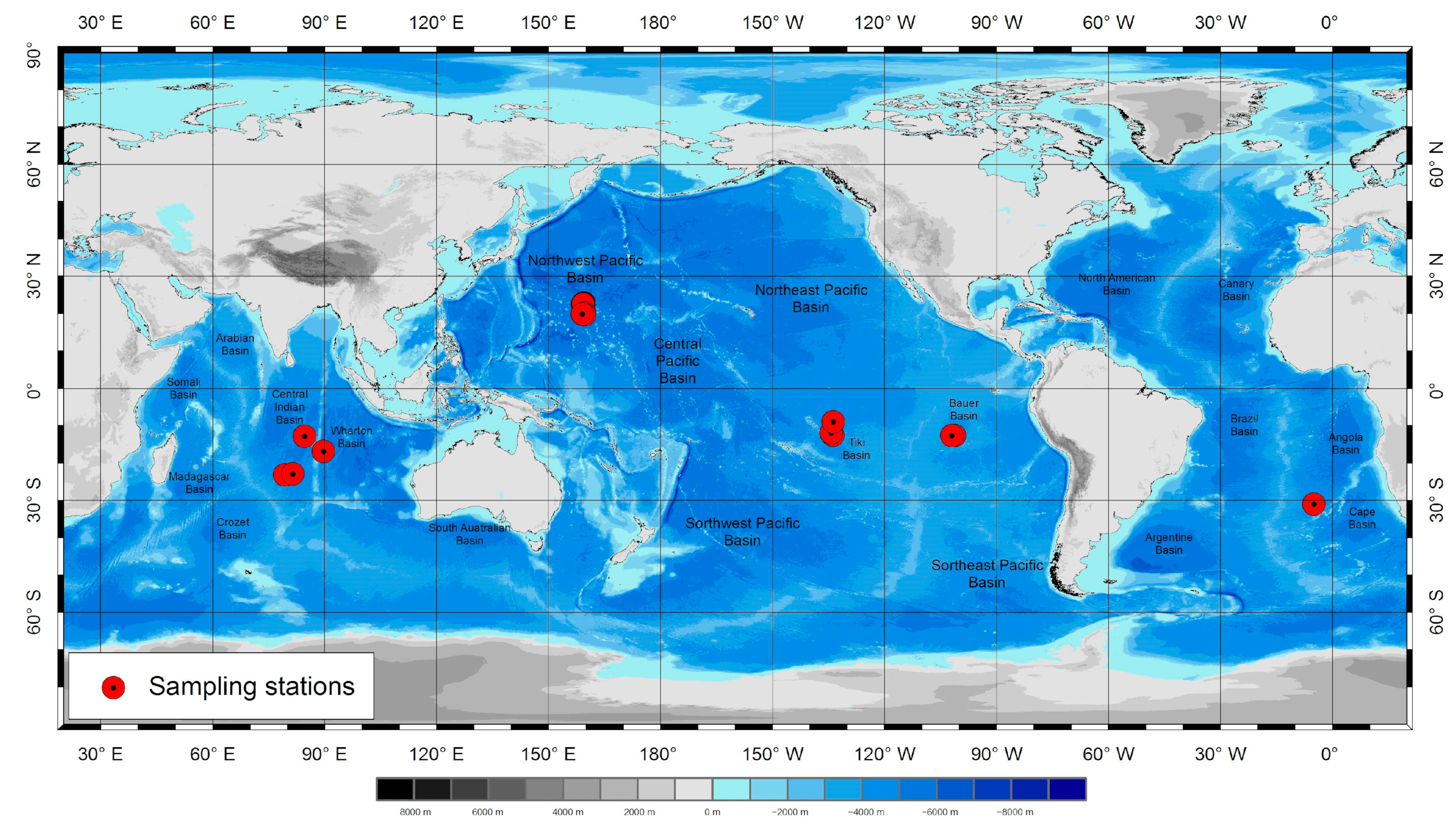
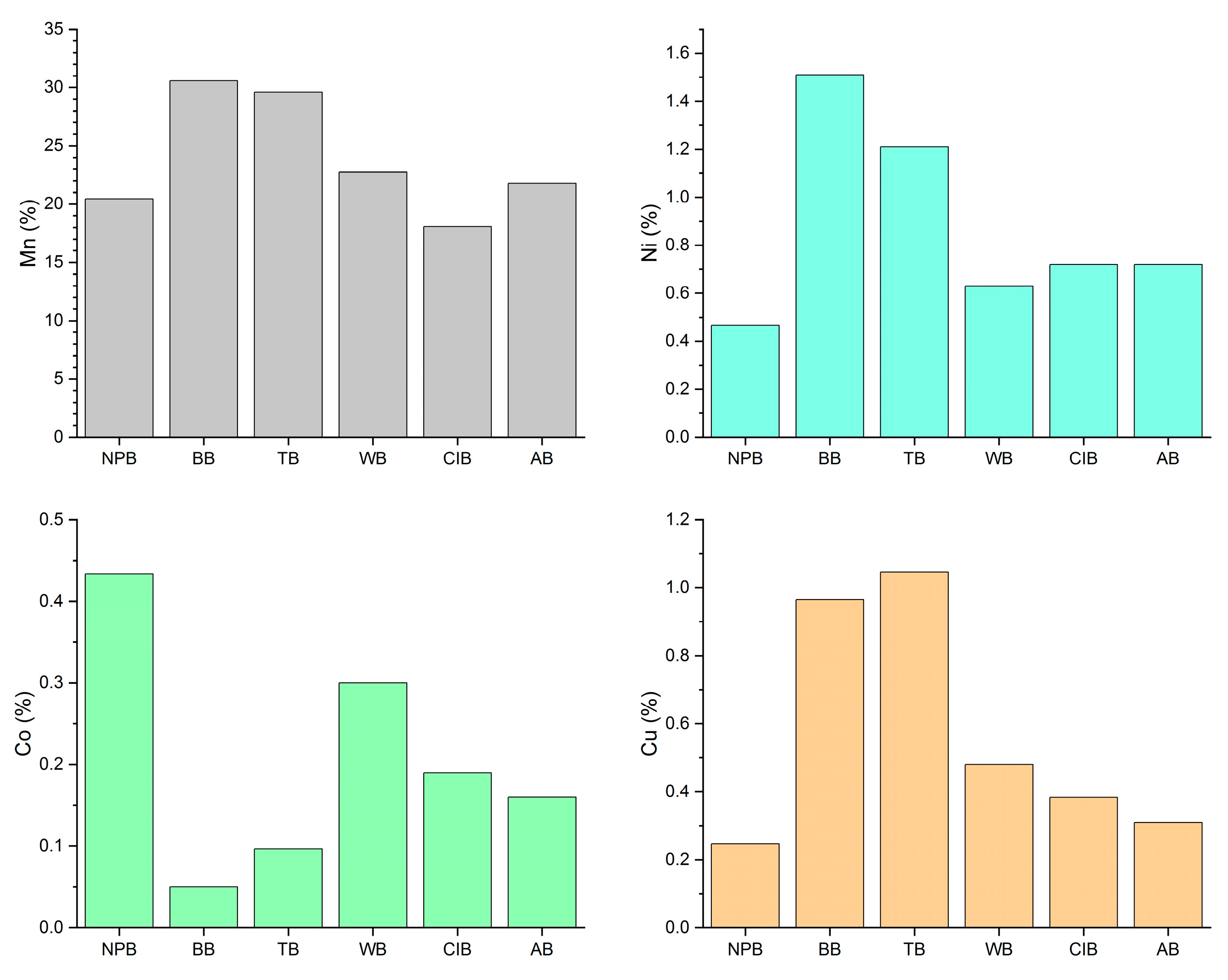
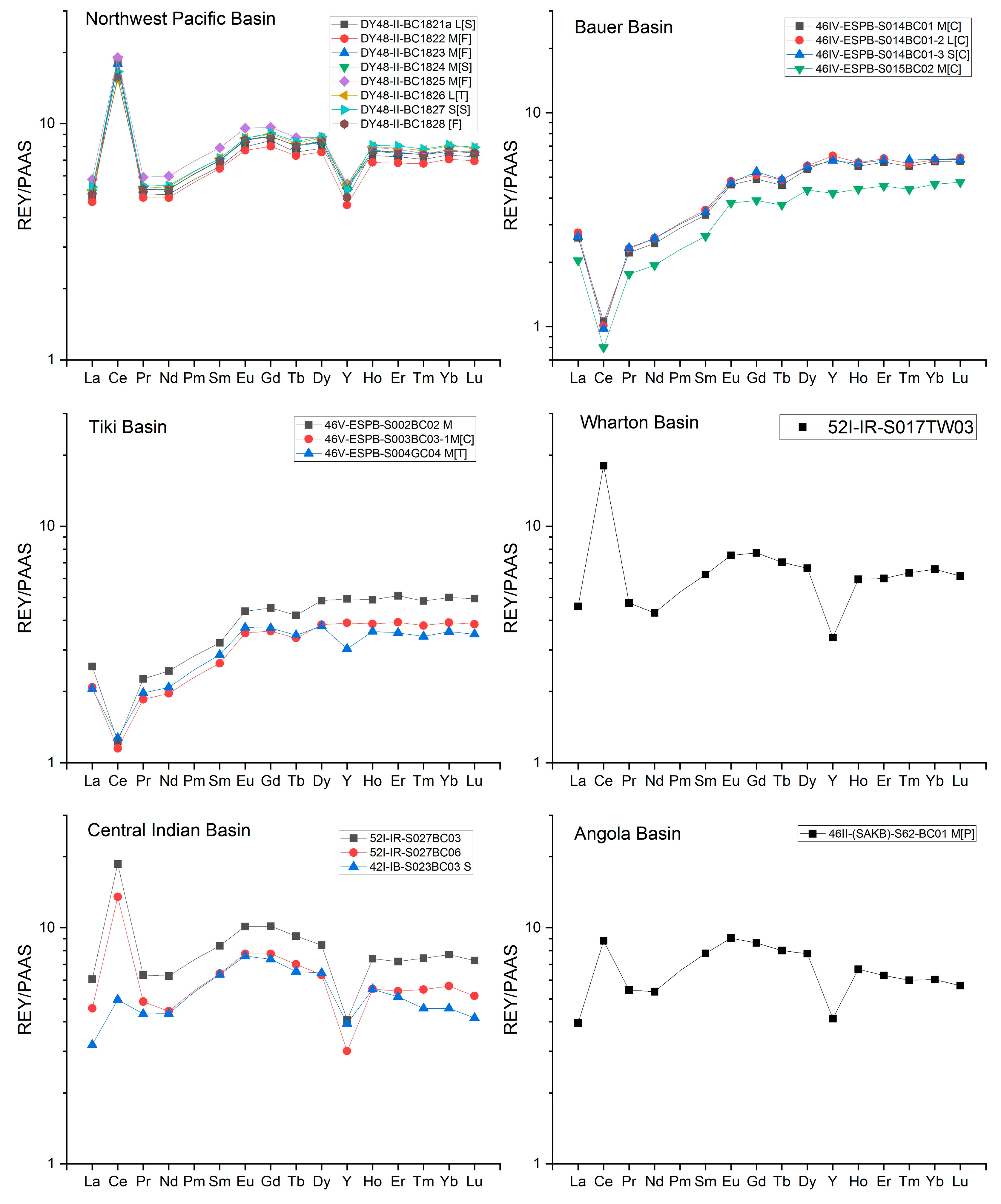
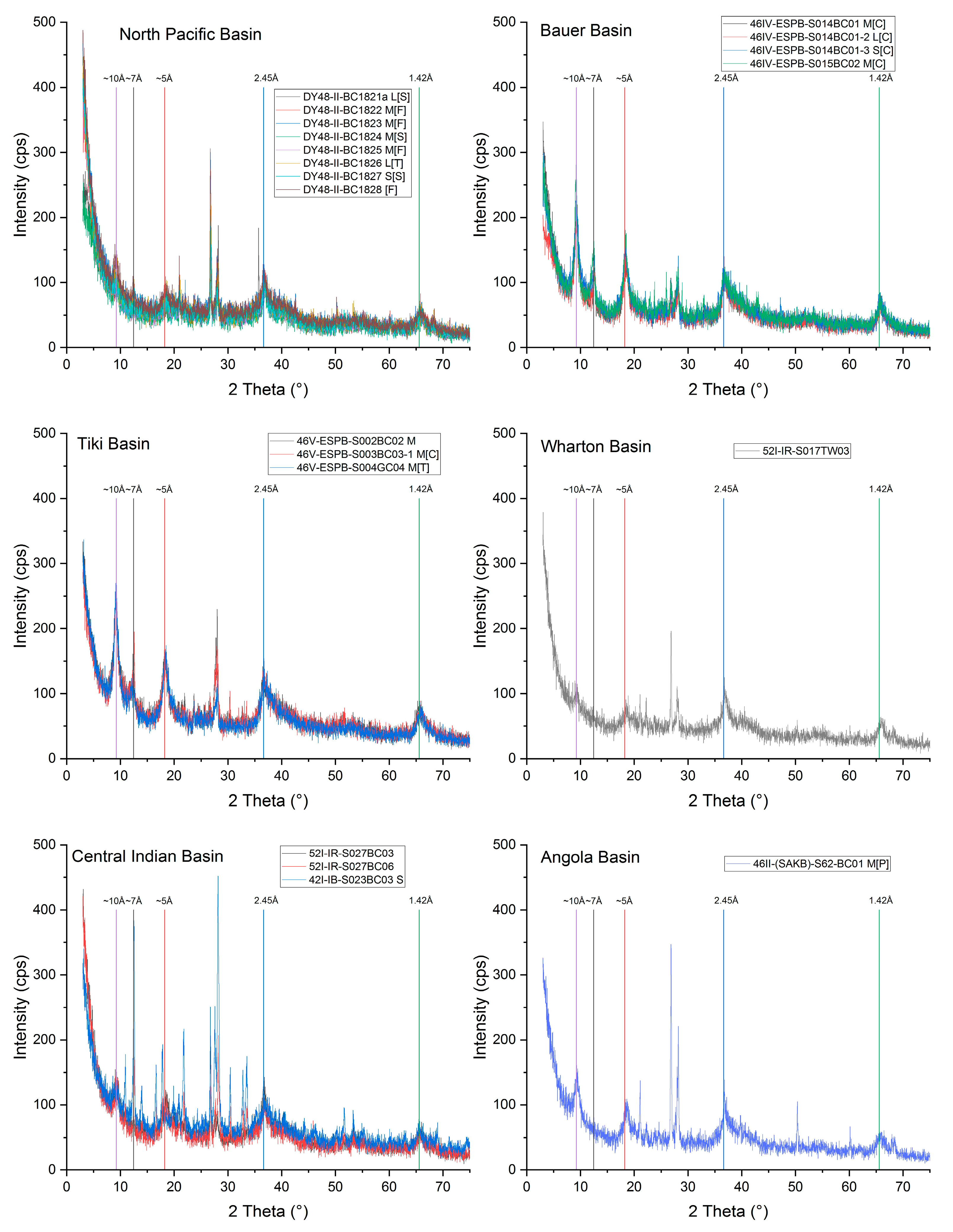
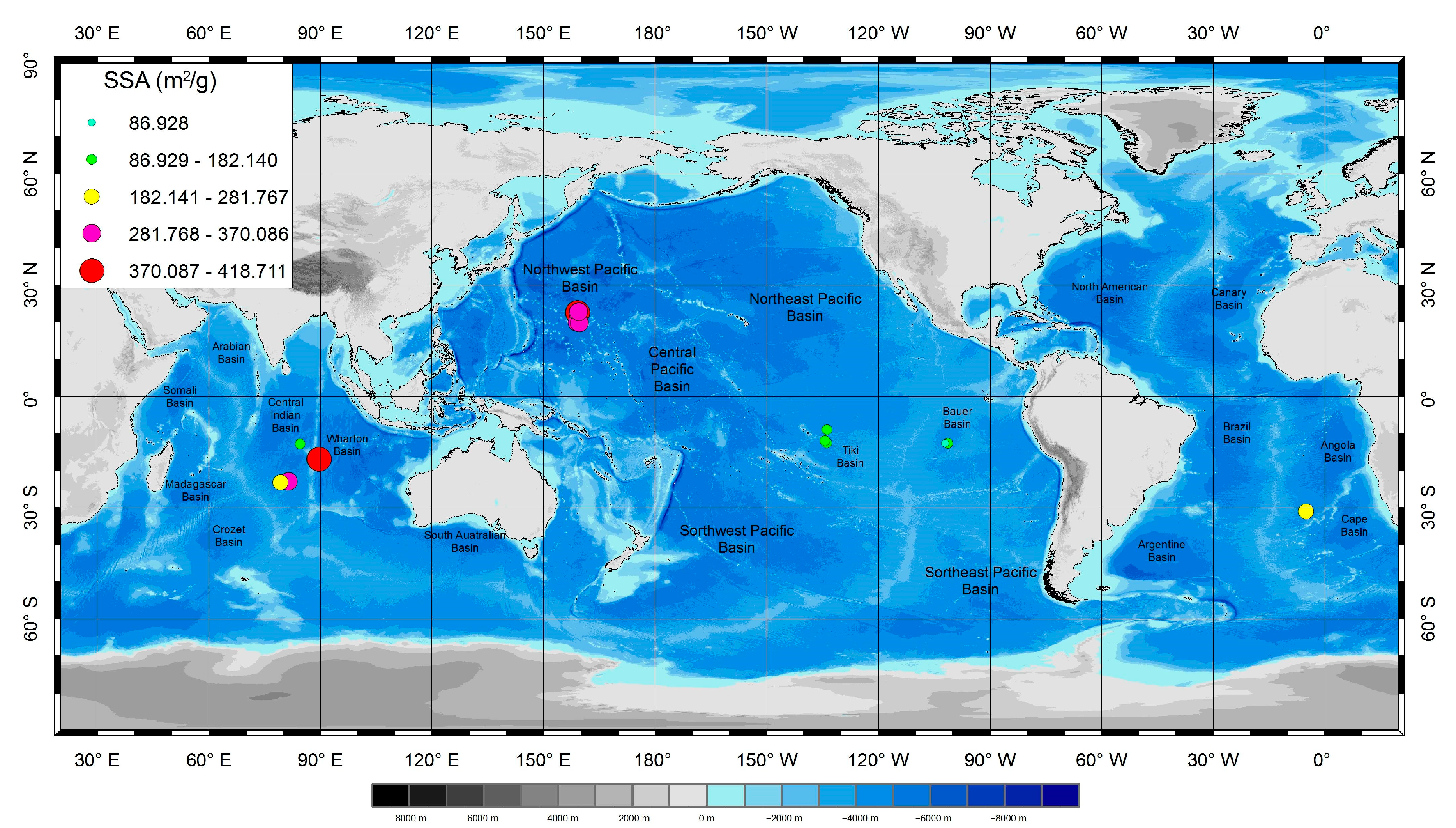
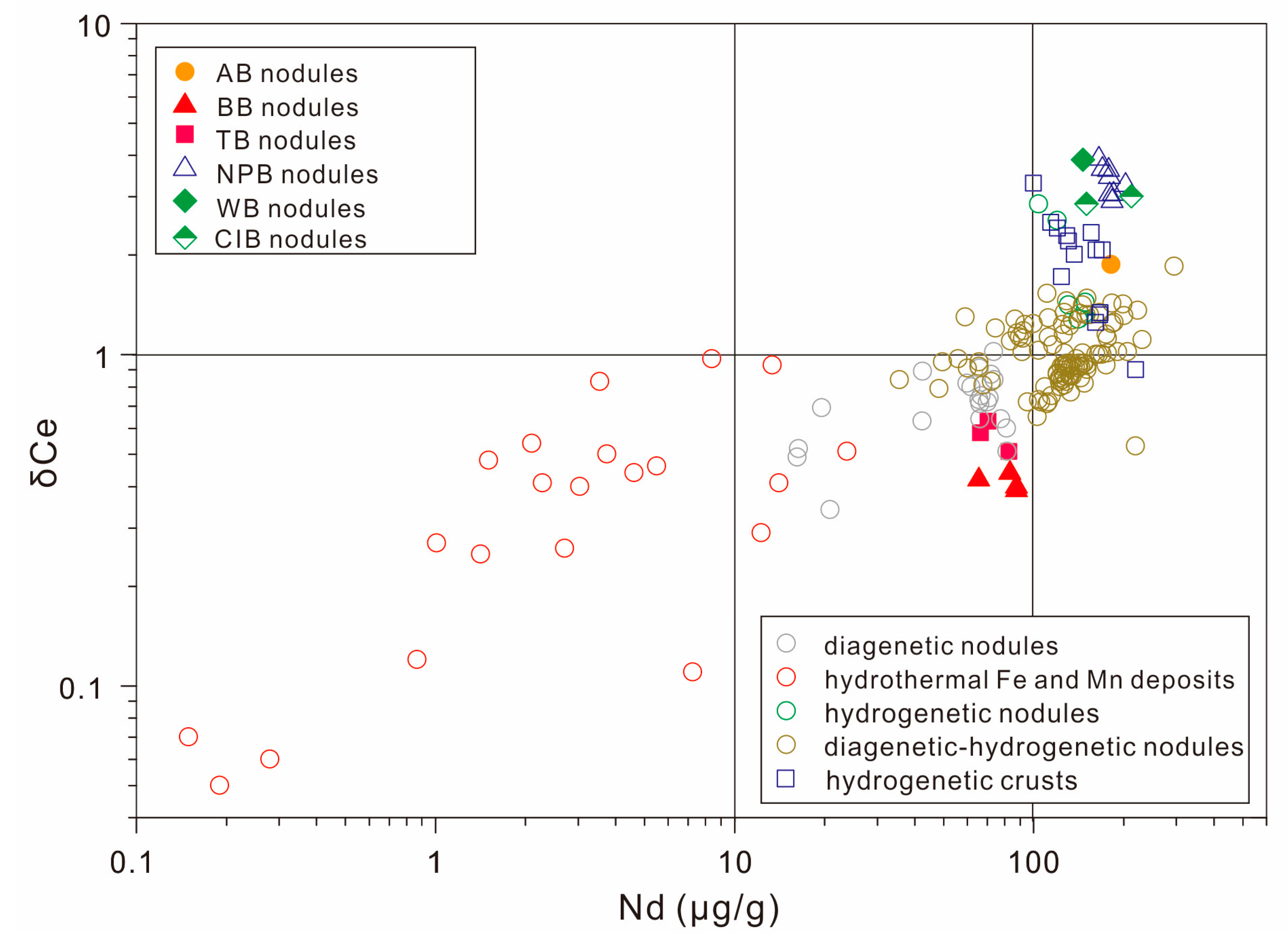
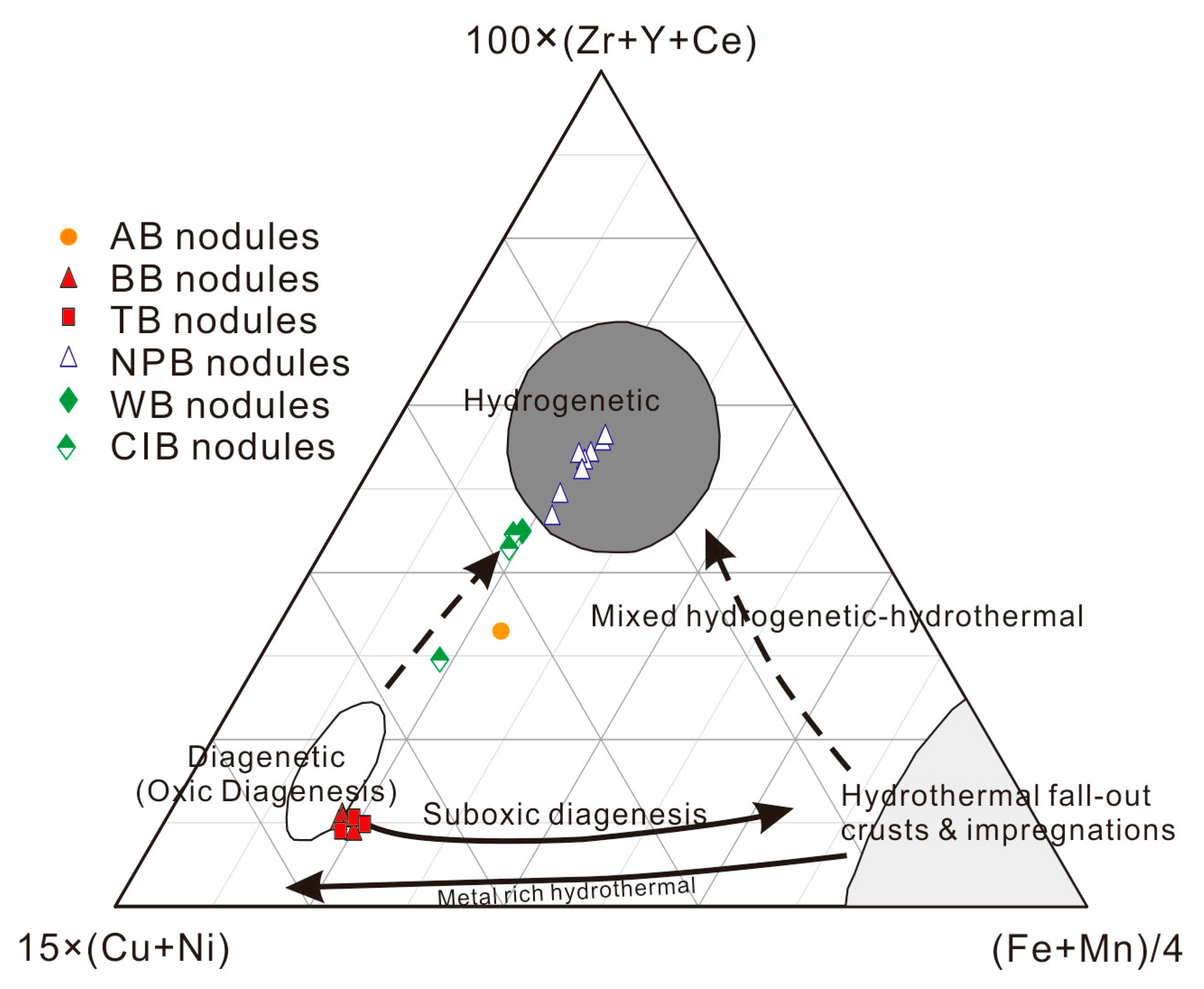
| Sample No. | Mn | Co | Cu | Ni | La | Ce | Pr | Nd | Sm | Eu | Gd | Tb | Dy | Ho | Er | Tm | Yb | Lu | Y | δCe | LREE | HREE | XRD10Å Peak Intensity | SSA | |
|---|---|---|---|---|---|---|---|---|---|---|---|---|---|---|---|---|---|---|---|---|---|---|---|---|---|
| % | % | % | % | μg/g | μg/g | μg/g | μg/g | μg/g | μg/g | μg/g | μg/g | μg/g | μg/g | μg/g | μg/g | μg/g | μg/g | μg/g | μg/g | μg/g | cps | m2/g | |||
| DY48-II-BC1821a L [S] | NPB | 20.98 | 0.46 | 0.20 | 0.45 | 187 | 1431 | 44.0 | 170 | 36.5 | 8.61 | 39.5 | 5.85 | 36.8 | 7.26 | 20.6 | 2.86 | 20.8 | 3.13 | 147 | 3.64 | 1877 | 284 | 94 | 370.086 |
| DY48-II-BC1822 M [F] | 20.53 | 0.42 | 0.23 | 0.36 | 178 | 1478 | 42.9 | 165 | 35.8 | 8.32 | 37.3 | 5.66 | 35.5 | 6.79 | 19.4 | 2.74 | 19.9 | 3.01 | 122 | 3.90 | 1908 | 252 | 78 | 329.440 | |
| DY48-II-BC1823 M [F] | 20.46 | 0.42 | 0.23 | 0.46 | 197 | 1429 | 46.5 | 179 | 38.8 | 9.24 | 41.2 | 6.22 | 39.3 | 7.57 | 21.4 | 3.00 | 21.6 | 3.25 | 147 | 3.44 | 1900 | 291 | 85 | 342.685 | |
| DY48-II-BC1824 M [S] | 19.68 | 0.44 | 0.19 | 0.39 | 196 | 1496 | 46.6 | 178 | 38.6 | 9.16 | 41.2 | 6.22 | 38.9 | 7.64 | 21.6 | 2.98 | 21.9 | 3.23 | 141 | 3.61 | 1965 | 285 | 102 | 418.711 | |
| DY48-II-BC1825 M [F] | 19.81 | 0.42 | 0.25 | 0.48 | 221 | 1517 | 52.3 | 203 | 43.8 | 10.30 | 45.0 | 6.75 | 41.0 | 7.87 | 22.2 | 3.03 | 21.7 | 3.27 | 150 | 3.25 | 2047 | 301 | 126 | 367.632 | |
| DY48-II-BC1826 L [T] | 19.92 | 0.42 | 0.30 | 0.52 | 200 | 1221 | 47.0 | 183 | 39.5 | 9.37 | 42.0 | 6.40 | 40.6 | 7.93 | 22.4 | 3.12 | 22.7 | 3.42 | 148 | 2.91 | 1700 | 297 | 124 | 355.589 | |
| DY48-II-BC1827 S [S] | 20.21 | 0.44 | 0.26 | 0.47 | 206 | 1320 | 48.1 | 185 | 39.5 | 9.35 | 42.5 | 6.51 | 41.1 | 8.01 | 22.9 | 3.16 | 22.9 | 3.44 | 142 | 3.06 | 1808 | 293 | 91 | 342.591 | |
| DY48-II-BC1828 [F] | 22.04 | 0.45 | 0.31 | 0.61 | 192 | 1250 | 46.5 | 179 | 38.6 | 9.20 | 40.9 | 6.26 | 39.4 | 7.60 | 21.5 | 2.98 | 21.5 | 3.25 | 132 | 3.05 | 1716 | 275 | 162 | 347.263 | |
| 46IV-ESPB-S014BC01 M [C] | BB | 29.49 | 0.05 | 0.97 | 1.55 | 100 | 84 | 19.6 | 83 | 18.5 | 4.98 | 22.8 | 3.56 | 25.5 | 5.58 | 16.7 | 2.28 | 16.7 | 2.58 | 164 | 0.44 | 310 | 260 | 240 | 167.087 |
| 46IV-ESPB-S014BC01-2 L [C] | 30.74 | 0.05 | 0.94 | 1.61 | 105 | 80 | 20.5 | 88 | 19.5 | 5.17 | 23.9 | 3.76 | 26.5 | 5.81 | 17.4 | 2.35 | 17.0 | 2.67 | 170 | 0.40 | 318 | 270 | 219 | 165.558 | |
| 46IV-ESPB-S014BC01-3 S [C] | 30.59 | 0.07 | 0.99 | 1.60 | 101 | 78 | 20.6 | 88 | 19.1 | 5.09 | 24.7 | 3.77 | 26.2 | 5.76 | 17.1 | 2.44 | 17.1 | 2.62 | 162 | 0.39 | 311 | 261 | 236 | 181.343 | |
| 46IV-ESPB-S015BC02 M [C] | 31.48 | 0.03 | 0.96 | 1.28 | 78 | 64 | 15.5 | 66 | 14.7 | 4.09 | 18.2 | 2.87 | 20.4 | 4.36 | 13.0 | 1.78 | 13.1 | 2.05 | 114 | 0.42 | 241 | 189 | 281 | 86.928 | |
| 46V-ESPB-S002BC02 M | TB | 28.18 | 0.09 | 0.97 | 1.21 | 97 | 98 | 20.0 | 83 | 17.8 | 4.72 | 21.0 | 3.25 | 22.7 | 4.84 | 14.5 | 1.96 | 14.1 | 2.14 | 133 | 0.51 | 321 | 217 | 250 | 152.216 |
| 46V-ESPB-S003BC03-1 M [C] | 28.97 | 0.10 | 1.13 | 1.23 | 79 | 91 | 16.3 | 66 | 14.6 | 3.81 | 16.8 | 2.60 | 17.9 | 3.82 | 11.2 | 1.54 | 11.0 | 1.67 | 105 | 0.59 | 272 | 172 | 257 | 135.417 | |
| 46V-ESPB-S004GC04 M [T] | 31.62 | 0.10 | 1.04 | 1.19 | 78 | 101 | 17.4 | 71 | 15.9 | 4.03 | 17.3 | 2.68 | 17.7 | 3.56 | 10.1 | 1.38 | 10.1 | 1.51 | 82 | 0.63 | 287 | 146 | 281 | 174.141 | |
| 52I-IR-S017TW03 | WB | 22.74 | 0.30 | 0.48 | 0.63 | 175 | 1437 | 41.7 | 146 | 34.7 | 8.14 | 36.0 | 5.45 | 31.1 | 5.90 | 17.1 | 2.57 | 18.6 | 2.66 | 91 | 3.88 | 1842 | 211 | 120 | 387.827 |
| 52I-IR-S027BC03 | CIB | 22.16 | 0.26 | 0.43 | 0.84 | 232 | 1482 | 55.7 | 212 | 46.6 | 10.90 | 47.3 | 7.15 | 39.5 | 7.34 | 20.6 | 3.01 | 21.7 | 3.15 | 110 | 3.01 | 2039 | 260 | 155 | 245.861 |
| 52I-IR-S027BC06 | 17.64 | 0.21 | 0.33 | 0.71 | 174 | 1076 | 43.0 | 150 | 35.5 | 8.38 | 36.2 | 5.43 | 29.6 | 5.46 | 15.4 | 2.22 | 16.0 | 2.23 | 81 | 2.87 | 1487 | 194 | 145 | 366.570 | |
| 42I-IB-S023BC03 S | 14.44 | 0.10 | 0.39 | 0.61 | 122 | 396 | 38.1 | 147 | 35.2 | 8.20 | 34.4 | 5.06 | 30.1 | 5.45 | 14.6 | 1.85 | 12.9 | 1.80 | 106 | 1.32 | 747 | 212 | 138 | 182.140 | |
| 46II-(SAKB)-S62-BC01 M [P] | AB | 21.79 | 0.16 | 0.31 | 0.72 | 151 | 701 | 48.1 | 182 | 43.3 | 9.77 | 40.2 | 6.20 | 36.4 | 6.61 | 17.9 | 2.43 | 17.0 | 2.46 | 111 | 1.87 | 1135 | 241 | 167 | 281.767 |
| Co | Ni | Cu | δCe | XRD Intensity at ~10 Å | SSA | ||
|---|---|---|---|---|---|---|---|
| Co | Pearson Correlation | 1 | |||||
| Sig. (2-tailed) | |||||||
| N | 20 | ||||||
| Ni | Pearson Correlation | −0.852 ** | 1 | ||||
| Sig. (2-tailed) | 0.000 | ||||||
| N | 20 | 20 | |||||
| Cu | Pearson Correlation | −0.871 ** | 0.935 ** | 1 | |||
| Sig. (2-tailed) | 0.000 | 0.000 | |||||
| N | 20 | 20 | 20 | ||||
| δCe | Pearson Correlation | 0.841 ** | −0.664 ** | −0.761 ** | 1 | ||
| Sig. (2-tailed) | 0.000 | 0.001 | 0.000 | ||||
| N | 20 | 20 | 20 | 20 | |||
| XRD intensity at ~10 Å | Pearson Correlation | −0.859 ** | 0.942 ** | 0.894 ** | −0.668 ** | 1 | |
| Sig. (2-tailed) | 0.000 | 0.000 | 0.000 | 0.001 | |||
| N | 20 | 20 | 20 | 20 | 20 | ||
| SSA | Pearson Correlation | 0.895 ** | −0.879 ** | −0.842 ** | 0.706 ** | −0.875 ** | 1 |
| Sig. (2-tailed) | 0.000 | 0.000 | 0.000 | 0.000 | 0.000 | ||
| N | 20 | 20 | 20 | 20 | 20 | 20 |
Disclaimer/Publisher’s Note: The statements, opinions and data contained in all publications are solely those of the individual author(s) and contributor(s) and not of MDPI and/or the editor(s). MDPI and/or the editor(s) disclaim responsibility for any injury to people or property resulting from any ideas, methods, instructions or products referred to in the content. |
© 2023 by the authors. Licensee MDPI, Basel, Switzerland. This article is an open access article distributed under the terms and conditions of the Creative Commons Attribution (CC BY) license (https://creativecommons.org/licenses/by/4.0/).
Share and Cite
Ren, X.; Li, H.; Yan, S.; Li, H.; Shi, X. Hydrogenetic and Diagenetic Controls on the Specific Surface Area of Polymetallic Nodules in Deep Ocean Basins. Minerals 2023, 13, 1431. https://doi.org/10.3390/min13111431
Ren X, Li H, Yan S, Li H, Shi X. Hydrogenetic and Diagenetic Controls on the Specific Surface Area of Polymetallic Nodules in Deep Ocean Basins. Minerals. 2023; 13(11):1431. https://doi.org/10.3390/min13111431
Chicago/Turabian StyleRen, Xiangwen, Haonan Li, Shijuan Yan, Huaiming Li, and Xuefa Shi. 2023. "Hydrogenetic and Diagenetic Controls on the Specific Surface Area of Polymetallic Nodules in Deep Ocean Basins" Minerals 13, no. 11: 1431. https://doi.org/10.3390/min13111431





